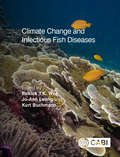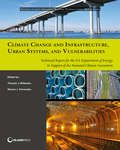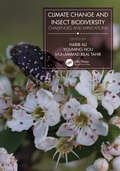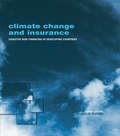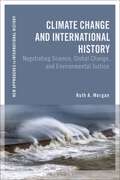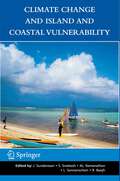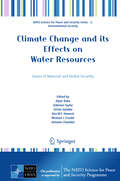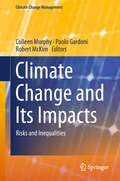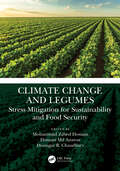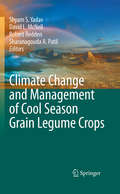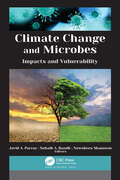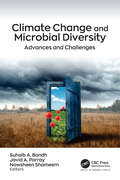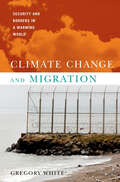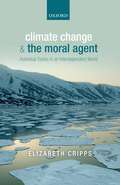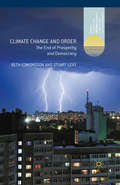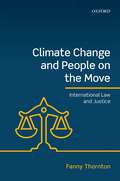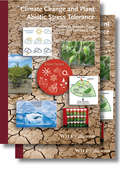- Table View
- List View
Climate Change and Infectious Fish Diseases
by Patrick T.K. Woo Jo-Ann Leong Kurt BuchmannClimate change with global warming is not disputed by the vast majority of scientists and the aquatic system is most affected. A global rise in water temperature and acidification of the aquatic environment will continue even if we can significantly reduce the current output of the two most important greenhouse gasses (carbon dioxide and methane). These and other environmental changes will affect fish health which includes infectious pathogens. This important new text is the second volume on climate change and fish health. It covers changes to the freshwater ecosystem and their current and expected effects on selected infectious diseases of fish. The book represents contributions by over 50 experts from 18 countries. Comprehensive and thought-provoking, the book details abiotic and biotic environmental changes in temperate and tropical freshwater ecosystems, sequestrations of atmospheric carbon dioxide and effects on infectious diseases (12 microbial and 10 parasitic) in economically important fish in tropical, subtropical and temperate waters. The text is key reading for fish disease scientists, aquatic ecologists, fish health consultants, veterinarians, policy makers and all who are interested in fish health and the environment.
Climate Change and Infrastructure, Urban Systems, and Vulnerabilities: Technical Report for the U.S. Department of Energy in Support of the National Climate Assessment (NCA Regional Input Reports)
by Thomas J. Wilbanks and Steven FernandezHurricane Irene ruptured a Baltimore sewer main, resulting in 100 million gallons of raw sewage flooding the local watershed. Levee failures during Hurricane Katrina resulted in massive flooding which did not recede for months. With temperatures becoming more extreme, and storms increasing in magnitude, American infrastructure and risk-management policies require close examination in order to decrease the damage wrought by natural disasters. Climate Change and Infrastructure, Urban Systems, and Vulnerabilities addresses these needs by examining how climate change affects urban buildings and communities, and determining which regions are the most vulnerable to environmental disaster. It looks at key elements of urban systems, including transportation, communication, drainage, and energy, in order to better understand the damages caused by climate change and extreme weather. How can urban systems become more resilient? How can citizens protect their cities from damage, and more easily rebound from destructive storms? This report not only breaks new ground as a component of climate change vulnerability and impact assessments but also highlights critical research gaps in the material. Implications of climate change are examined by assessing historical experience as well as simulating future conditions.Developed to inform the 3rd National Climate Assessment, and a landmark study in terms of its breadth and depth of coverage and conducted under the auspices of the U.S. Department of Energy, Climate Change and Infrastructure, Urban Systems, and Vulnerabilities examines the known effects and relationships of climate change variables on American infrastructure and risk-management policies. Its rich science and case studies will enable policymakers, urban planners, and stakeholders to develop a long-term, self-sustained assessment capacity and more effective risk-management strategies.
Climate Change and Insect Biodiversity: Challenges and Implications
by Habib Ali Youming Hou Muhammad Bilal TahirThis up-to-date reference book discusses the effects of climate change on the biodiversity of insect pests. The changing climate and agricultural intensification practices impact negatively on insect biodiversity. The book explains the significance of insect pests for evaluating climatic impacts on a wide range of ecological systems. It covers the effect of climate change on pollinators and household and agricultural insect pests. It explains how climate-smart agriculture can enhance productivity and food security.FEATURES Reviews the effects of climate change on plant-insect interactions Includes topics such as insect biodiversity informatics and conservation Discusses food security, pest management, and beneficial and social insects Covers topics such as precision agriculture and climate-smart agriculture Provides insights on the relation between agriculture intensification and insect biodiversity This book is meant for scientists, researchers, and students working in the fields of agriculture, entomology, ecology, plant science, environmental biology, and biotechnology.
Climate Change and Insect Biodiversity: Challenges and Implications
This up-to-date reference book discusses the effects of climate change on the biodiversity of insect pests. The changing climate and agricultural intensification practices impact negatively on insect biodiversity. The book explains the significance of insect pests for evaluating climatic impacts on a wide range of ecological systems. It covers the effect of climate change on pollinators and household and agricultural insect pests. It explains how climate-smart agriculture can enhance productivity and food security.FEATURES Reviews the effects of climate change on plant-insect interactions Includes topics such as insect biodiversity informatics and conservation Discusses food security, pest management, and beneficial and social insects Covers topics such as precision agriculture and climate-smart agriculture Provides insights on the relation between agriculture intensification and insect biodiversity This book is meant for scientists, researchers, and students working in the fields of agriculture, entomology, ecology, plant science, environmental biology, and biotechnology.
Climate Change and Insurance: Disaster Risk Financing in Developing Countries
by Eugene N. GurenkoClimate change brings about a new set of major economic risks arising from changing weather patterns, extreme weather events and rising sea levels. Most at risk are developing countries who, despite considerable post-disaster donor aid, have been bearing the major brunt of disaster-related losses. One adaptation solution that is rapidly gaining the support of countries and international donors is a risk transfer to the global reinsurance and capital markets. This volume, a special issue of the journal Climate Policy, explores the role that insurance-based mechanisms can play in helping developing countries prepare for climate change. It offers a unique and comprehensive perspective on the potential role of insurance solutions in global adaptation to climate change and attempts to engender debate on the role of insurance in reducing global emissions and encouraging climate-friendly corporate behaviour.
Climate Change and Insurance: Disaster Risk Financing in Developing Countries
by Eugene N. GurenkoClimate change brings about a new set of major economic risks arising from changing weather patterns, extreme weather events and rising sea levels. Most at risk are developing countries who, despite considerable post-disaster donor aid, have been bearing the major brunt of disaster-related losses. One adaptation solution that is rapidly gaining the support of countries and international donors is a risk transfer to the global reinsurance and capital markets. This volume, a special issue of the journal Climate Policy, explores the role that insurance-based mechanisms can play in helping developing countries prepare for climate change. It offers a unique and comprehensive perspective on the potential role of insurance solutions in global adaptation to climate change and attempts to engender debate on the role of insurance in reducing global emissions and encouraging climate-friendly corporate behaviour.
Climate Change and International History: Negotiating Science, Global Change, and Environmental Justice (New Approaches to International History)
by Ruth A. MorganExploring how climate change has configured the international arena since the 1950s, this book reveals the ways in which climate change emerged and evolved as an international problem, and how states, scientists and NGOs have engaged in diplomatic efforts to address it. Developing amidst the Cold War, decolonization and a growing transnational environmental consciousness, it asks how this wider historical context has shaped our response to the greatest threat to humankind to date. Thinking beyond the science of climate change to the way it is received and responded to, Ruth Morgan shows how climate science has been mobilised in the political sphere, paying particular attention to the expansion of climate diplomacy into the Global South. The privileging of climate science and the emergence of climate scepticism are explored to consider how they have undermined efforts to remedy this planetary problem. Studying climate change and international history in tandem, this book explains the origins of the debates around this environmental emergency, the response of political leaders attempting to address the threat, and the barriers we face in creating an international regime to resolve the climate crisis.
Climate Change and International History: Negotiating Science, Global Change, and Environmental Justice (New Approaches to International History)
by Ruth A. MorganExploring how climate change has configured the international arena since the 1950s, this book reveals the ways in which climate change emerged and evolved as an international problem, and how states, scientists and NGOs have engaged in diplomatic efforts to address it. Developing amidst the Cold War, decolonization and a growing transnational environmental consciousness, it asks how this wider historical context has shaped our response to the greatest threat to humankind to date. Thinking beyond the science of climate change to the way it is received and responded to, Ruth Morgan shows how climate science has been mobilised in the political sphere, paying particular attention to the expansion of climate diplomacy into the Global South. The privileging of climate science and the emergence of climate scepticism are explored to consider how they have undermined efforts to remedy this planetary problem. Studying climate change and international history in tandem, this book explains the origins of the debates around this environmental emergency, the response of political leaders attempting to address the threat, and the barriers we face in creating an international regime to resolve the climate crisis.
Climate Change and Island and Coastal Vulnerability
by J. Sundaresan S. Sreekesh A. L. Ramanathan Leonard Sonnenschein Ram Boojh"Climate Change and Island and Coastal Vulnerability” is the outcome of a selection of peer reviewed edited papers presented at the International Workshop on Climate Change and Island Vulnerability (IWCCI) held at Kadmat Island, Lakshadweep, India in October 2010. Marine and coastal biodiversity, sea level rise vulnerability, fisheries, climate change impact on livelihood options, water and sanitation in island ecosystem and mitigation, adaptation and governance are the focal themes. The basic concept conveyed in the book is that biodiversity of islands is to be protected as a natural mechanism to mitigate climate change. Probability recurrence of mass coral bleaching and the management of coral reefs and their future protection are discussed in this book. Marine productivity and climate change for the last ten thousand years in the Arabian Sea have been examined with core records. Green technology is suggested as an important tool for mitigation and adaptation programmes in climate change. Measures taken to project biomass utilisation of islands as an energy source is delineated. Climate change may pose a potential threat on human health. Improved sanitation packages and models that are cost effective and environment-friendly for islands are uniquely presented in this book.
Climate Change and its Effects on Water Resources: Issues of National and Global Security (NATO Science for Peace and Security Series C: Environmental Security)
by Alper Baba, Gökmen Tayfur, Orhan J. Gündüz, Ken W.F. Howard, Michael J. W. F. Friedel and Antonio ChambelNational and global security can be assessed in many ways but one underlying factor for all humanity is access to reliable sources of water for drinking, sanitation, food production and manufacturing industry. In many parts of the world, population growth and an escalating demand for water already threaten the sustainable management of available water supplies. Global warming, climate change and rising sea level are expected to intensify the resource sustainability issue in many water-stressed regions of the world by reducing the annual supply of renewable fresh water and promoting the intrusion of saline water into aquifers along sea coasts, where 50% of the global population reside. Pro-active resource management decisions are required, but such efforts would be futile unless reliable predictions can be made about the impact of the changing global conditions on the water cycle and the quality and availability of critical water reserves. Addressing this wide spectrum of issues, a team of expert authors discusses here the impacts of climate change on the global water resources, the long-term resource management goals at global and local scales, the data requirements and the scientific and technical advances necessary to mitigate the associated impacts.
Climate Change and Its Impacts: Risks and Inequalities (Climate Change Management)
by Colleen Murphy Paolo Gardoni Robert McKimResponding to a need for a deeper and more nuanced understanding of the consequences of climate change, this book brings experts in climate science, engineering, urban planning, and conservation biology into conversation with scholars in law, geography, anthropology and ethics. It provides insights into how climate change is conceptualized in different fields. The book also aims to contribute to developing successful and multifaceted strategies that promote global, intergenerational and environmental justice. Among the topics addressed are the effects of climate change on the likelihood and magnitude of natural hazards, an assessment of civil infrastructure vulnerabilities, resilience assessment for coastal communities, an ethical framework to evaluate behavior that contributes to climate change, as well as policies and cultural shifts that might help humanity to respond adequately to climate change.
Climate Change and Legumes: Stress Mitigation for Sustainability and Food Security
by Mohammad Zabed Hossain Hossain Anawar Doongar R. ChaudharyGlobal climate change has created unprecedented challenges for human civilization due to its widespread adverse consequences, including a reduction in crop yield and threatening food security across the globe. Among the crop plants, legumes have great potential for ameliorating global warming since they can reduce carbon emissions by lowering reliance on the application of chemical fertilizers, by increasing nitrification and carbon sequestration in soil, and by providing protein-rich diets to both humans and livestock. This book identifies the extent of climate-induced stresses on legume plants and focuses on achieving food security through sustainable agricultural practices.This book compiles recent research findings and reviews on climate-related problems, the potential of legumes in ameliorating the impacts of climate change, as well as better management of agricultural land and practices for achieving environmental sustainability and food security.This book will serve as guidelines for scientists, agricultural practitioners, and policymakers working to achieve food security and better management of climate-induced stresses in agricultural interventions. It will also be useful as a reference book for researchers and students of both graduate and postgraduate levels. Furthermore, this book will provide enhanced knowledge about the mechanisms of yield and stress tolerance of legumes as well as developing climate-smart crops and improving cropping systems for a sustainable environment and food security. Features of the book Reviews trends of global climate change and its consequences for food security across the continents Identifies the challenges and scopes of cultivating legumes in achieving food security in the context of global climate change Focuses on the improvements of legume production through conservation approaches in agricultural practices and modern techniques, including omics-based breeding, biotechnology, genetic engineering, and rhizobium technology Discusses the sustainable amelioration options for soils affected by climate-induced stresses Cites examples of applications of rhizobium technologies in reducing greenhouse gas emission Describes pathways associated with yield, resistance, and tolerance of legumes to climate-induced stresses
Climate Change and Legumes: Stress Mitigation for Sustainability and Food Security
Global climate change has created unprecedented challenges for human civilization due to its widespread adverse consequences, including a reduction in crop yield and threatening food security across the globe. Among the crop plants, legumes have great potential for ameliorating global warming since they can reduce carbon emissions by lowering reliance on the application of chemical fertilizers, by increasing nitrification and carbon sequestration in soil, and by providing protein-rich diets to both humans and livestock. This book identifies the extent of climate-induced stresses on legume plants and focuses on achieving food security through sustainable agricultural practices.This book compiles recent research findings and reviews on climate-related problems, the potential of legumes in ameliorating the impacts of climate change, as well as better management of agricultural land and practices for achieving environmental sustainability and food security.This book will serve as guidelines for scientists, agricultural practitioners, and policymakers working to achieve food security and better management of climate-induced stresses in agricultural interventions. It will also be useful as a reference book for researchers and students of both graduate and postgraduate levels. Furthermore, this book will provide enhanced knowledge about the mechanisms of yield and stress tolerance of legumes as well as developing climate-smart crops and improving cropping systems for a sustainable environment and food security. Features of the book Reviews trends of global climate change and its consequences for food security across the continents Identifies the challenges and scopes of cultivating legumes in achieving food security in the context of global climate change Focuses on the improvements of legume production through conservation approaches in agricultural practices and modern techniques, including omics-based breeding, biotechnology, genetic engineering, and rhizobium technology Discusses the sustainable amelioration options for soils affected by climate-induced stresses Cites examples of applications of rhizobium technologies in reducing greenhouse gas emission Describes pathways associated with yield, resistance, and tolerance of legumes to climate-induced stresses
Climate Change and Management of Cool Season Grain Legume Crops
by Shyam Singh Yadav Robert ReddenThis book covers all aspect of legume production management technologies, plant ecological response, nutrients management, biological nitrogen fixation, molecular approaches, potential cultivars, biodiversity management under climate change. Also covered are various aspects of legume management under climate change such as, production management technology, ecology & adaptation, diseases, and international trade; physiology and crops response to nutrients, drought, salinity, and water use efficiency; Biodiversity management, molecular approaches and biological Nitrogen fixation; climate change and strategies. This book presents the most comprehensive and up to date review of research on different cool season grain legume crops, nutrients management, biotic and abiotic stresses management, agronomical approaches for drought management, salinity, drought, weed management and water use efficiency, impact on international trade around the world.
Climate Change and Microbes: Impacts and Vulnerability
by Javid A. ParrayThis book provides an enlightening picture of the role of microbes for sustaining life systems and how climatic factors will change the course of the processes. Climate Change and Microbes: Impacts and Vulnerability explores the little-addressed issue of the effects of climate change on microbial ecosystems and the influence of climate change on microbiome diversity across various habitats and regions. Recent years have seen the evidence that microbial communities are neither immune to disruption nor do they have the capacity to recover completely after a stressful climate event. This volume documents the important role of microorganisms as climate engineers and considers mitigation and adaptation strategies as well. It goes on to present the research that addresses a diverse array of topics on the impact of climate change on plant-microbe interactions and microbial aquatic life and change-induced aggravations in microbial populations and processes. The book also addresses microbial foodborne diseases resulting from challenging climates. Other topics include algae as indicators of climate change and strategies for facilitating sustainable agro-ecosystems. This book will be immensely helpful in the study of plant microbiology, agricultural sciences, biotechnology, climate science, and environmental microbiology. It will also be applicable to the field of microbial biotechnology, agricultural, and other life and environmental sciences.
Climate Change and Microbes: Impacts and Vulnerability
by Javid A. Parray Suhaib A. Bandh Nowsheen ShameemThis book provides an enlightening picture of the role of microbes for sustaining life systems and how climatic factors will change the course of the processes. Climate Change and Microbes: Impacts and Vulnerability explores the little-addressed issue of the effects of climate change on microbial ecosystems and the influence of climate change on microbiome diversity across various habitats and regions. Recent years have seen the evidence that microbial communities are neither immune to disruption nor do they have the capacity to recover completely after a stressful climate event. This volume documents the important role of microorganisms as climate engineers and considers mitigation and adaptation strategies as well. It goes on to present the research that addresses a diverse array of topics on the impact of climate change on plant-microbe interactions and microbial aquatic life and change-induced aggravations in microbial populations and processes. The book also addresses microbial foodborne diseases resulting from challenging climates. Other topics include algae as indicators of climate change and strategies for facilitating sustainable agro-ecosystems. This book will be immensely helpful in the study of plant microbiology, agricultural sciences, biotechnology, climate science, and environmental microbiology. It will also be applicable to the field of microbial biotechnology, agricultural, and other life and environmental sciences.
Climate Change and Microbial Diversity: Advances and Challenges
by Suhaib A. Bandh Javid A. Parray Nowsheen ShameemThe ongoing global climate change triggered by greenhouse gas growth has had a significant effect on the microbial dynamics of plants and soils. This volume explores the various microbial responses of plants and soils caused directly or indirectly by climate change resulting from rising greenhouse gases and other factors. The book considers the rapidly changing environment and the important role of microbiomes in restoring soil and plant health and in creating sustainable approaches. It discusses the adaptation and mitigation of plants and soils, specifically addressing such topics as biogeochemical processes, antimicrobial resistance, the dynamics of bacteria and fungus in extreme environments, bacterial siderophores for sustainability, and more. The volume also looks at edaphic and regeneration performance of tree species in the temperate forests.
Climate Change and Microbial Diversity: Advances and Challenges
by Suhaib A. Bandh, Javid A. Parray and Nowsheen ShameemThe ongoing global climate change triggered by greenhouse gas growth has had a significant effect on the microbial dynamics of plants and soils. This volume explores the various microbial responses of plants and soils caused directly or indirectly by climate change resulting from rising greenhouse gases and other factors. The book considers the rapidly changing environment and the important role of microbiomes in restoring soil and plant health and in creating sustainable approaches. It discusses the adaptation and mitigation of plants and soils, specifically addressing such topics as biogeochemical processes, antimicrobial resistance, the dynamics of bacteria and fungus in extreme environments, bacterial siderophores for sustainability, and more. The volume also looks at edaphic and regeneration performance of tree species in the temperate forests.
Climate Change and Migration: Security and Borders in a Warming World
by Gregory WhiteFocusing on climate-induced migration from Africa to Europe, Climate Change and Migration shows how global warming's impact on international relations has been significant, enhancing the security regimes in not only the advanced economies of the North Atlantic, but in the states that serve as transit points between the most advanced and most desperate nations. With an in-depth coverage of both environmental and border policy from a global perspective, the book provides a provocative and much-needed link between two of the most pressing issues in contemporary international politics.
Climate Change And The Moral Agent: Individual Duties In An Interdependent World
by Elizabeth CrippsMany of us take it for granted that we ought to cooperate to tackle climate change. But where does this requirement come from and what does it mean for us as individuals trying to do the right thing? Although climate change does untold harm to our fellow humans and to the non-human world, no one causes it on their own and it is not the result of intentionally collective action. In the face of the current failure of institutions to confront the problem, is there anything we can do as individuals that will leave us able to live with ourselves? This book responds to these challenges. It makes a moral case for collective action on climate change by appealing to moralized collective self-interest, collective ability to aid, and an expanded understanding of collective responsibility for harm. It also argues that collective action is something we owe to ourselves, as moral agents, because without it we are left facing marring choices. In the absence of collective action, individuals should focus on trying to promote such action (whether through or by bypassing existing institutions), with a supplementary duty to aid victims directly. The argument is not that we should not be cutting our own emissionsthis can be a vital part of bringing about collective action or alleviating harmbut that such `green lifestyle choices cannot straightforwardly be defended as duties in their own right, and should not take priority over trying to bring about collective change.
Climate Change and Order: The End of Prosperity and Democracy (Energy, Climate and the Environment)
by Beth Edmondson Stuart LevyBeth Edmondson and Stuart Levy examine why it is so difficult for the international community to respond to global climate change. In doing so, they analyse and explain some of the strategies that might ultimately provide the foundations for appropriate responses.
Climate Change and People on the Move: International Law and Justice
by Fanny ThorntonThis book applies a justice framework to analysis of the actual and potential role of international law with respect to people on the move in the context of anthropogenic climate change. That people are affected by the impacts of climate change is no longer doubted, including with implications for people movement (migration, displacement, relocation, etc.). Climate Change and People on the Move tackles unique questions concerning international responsibility for people movement arising from the inequities inherent to climate change. Corrective and distributive justice provide the analytical backbone, and are explored in a substantial theoretical chapter and then applied to subsequent contextual analysis. Corrective justice supports analysis as to whether people movement in the climate change context could be conceived or framed as harm, loss, or damage which is compensable under international law, either through fault-centred regimes or no-fault regimes (i.e. insurance). Distributive justice supports analysis as to whether such movement could be conceived or framed as a disproportionate burden, either for those faced with movement or those faced with sheltering people on the move, from which duties of re-distribution may stem. This book contributes to the growing scholarship and analysis concerning international law or governance and people movement in response to the impacts of climate change by investigating the bounds of the law where the phenomenon is viewed as one of (in)justice.
Climate Change and People on the Move: International Law and Justice
by Fanny ThorntonThis book applies a justice framework to analysis of the actual and potential role of international law with respect to people on the move in the context of anthropogenic climate change. That people are affected by the impacts of climate change is no longer doubted, including with implications for people movement (migration, displacement, relocation, etc.). Climate Change and People on the Move tackles unique questions concerning international responsibility for people movement arising from the inequities inherent to climate change. Corrective and distributive justice provide the analytical backbone, and are explored in a substantial theoretical chapter and then applied to subsequent contextual analysis. Corrective justice supports analysis as to whether people movement in the climate change context could be conceived or framed as harm, loss, or damage which is compensable under international law, either through fault-centred regimes or no-fault regimes (i.e. insurance). Distributive justice supports analysis as to whether such movement could be conceived or framed as a disproportionate burden, either for those faced with movement or those faced with sheltering people on the move, from which duties of re-distribution may stem. This book contributes to the growing scholarship and analysis concerning international law or governance and people movement in response to the impacts of climate change by investigating the bounds of the law where the phenomenon is viewed as one of (in)justice.
Climate Change and Plant Abiotic Stress Tolerance
by Narendra Tuteja Sarvajeet S. GillIn this ready reference, a global team of experts comprehensively cover molecular and cell biology-based approaches to the impact of increasing global temperatures on crop productivity. The work is divided into four parts. Following an introduction to the general challenges for agriculture around the globe due to climate change, part two discusses how the resulting increase of abiotic stress factors can be dealt with. The third part then outlines the different strategies and approaches to address the challenge of climate change, and the whole is rounded off by a number of specific examples of improvements to crop productivity. With its forward-looking focus on solutions, this book is an indispensable help for the agro-industry, policy makers and academia.
Climate Change and Plant Abiotic Stress Tolerance
by Narendra Tuteja Sarvajeet S. GillIn this ready reference, a global team of experts comprehensively cover molecular and cell biology-based approaches to the impact of increasing global temperatures on crop productivity. The work is divided into four parts. Following an introduction to the general challenges for agriculture around the globe due to climate change, part two discusses how the resulting increase of abiotic stress factors can be dealt with. The third part then outlines the different strategies and approaches to address the challenge of climate change, and the whole is rounded off by a number of specific examples of improvements to crop productivity. With its forward-looking focus on solutions, this book is an indispensable help for the agro-industry, policy makers and academia.
